- Home
- William Kennedy
Riding the Yellow Trolley Car: Selected Nonfiction Page 12
Riding the Yellow Trolley Car: Selected Nonfiction Read online
Page 12
The Jewish aspect of the book is a deeply enriching factor, but the book is not merely a study of Jewishness. The Jew is Malamud’s metaphor for any man who suffers. Totally alone with his suffering, the Malamud hero somehow manages to outwit fatalism and avoid despair. How does this happen to the unprotected, existential, persecuted man of this modern era? Other authors find modern man adrift in absurdity, bereft of meaning, hopeless of salvation. But Malamud’s men are redeemed, always by themselves.
“It’s an idea of yourself,” Malamud said, “an ideal that makes human beings die for certain purposes. You find it in the philosophy of Spinoza [which Yakov Bok occasionally reads] who paid a serious price to promulgate his ideas of life and the universe as he saw it.”
It’s evident, he adds, in many acts of heroism. People who suffer dangers do so because they have “an attitude that it’s worth it.” Perhaps the suffering, is to renew your own life, or for a woman, or an ideal, but “it does depend on an idea that you have.”
“It’s the same reason we live,” he said. “I think most people do think they are living for something—some because their lives are comfortable with beer and TV, some because life is a challenge, a mystery, and some because they have nothing else to do. It varies. But it is the old eternal man that you admire most in literature—the man who must know where he is and who manages to oppose the gods and go on living.”
What the Malamud hero represents is that “life is worth living, no matter what the odds.” Says the author: “It’s an affirmation of life we’re dealing with here—people who find life too holy to waste.” Of himself he says: “I’m a strong believer in possibility. I believe the surprises of life are extraordinary. I take pleasure that I have a family and that my position as a teacher and writer are not difficult for me.”
He quoted the view of Thomas Hobbes, who said that life was “nasty, brutish and short,” and Malamud adds: “As long as we have life we may outwit that view.”
1966
Pictures of Fidelman: A Review
Innocence, guilt, stupidity, fateful Jewishness, and other abstractions have consistently ganged up on the heroes of Bernard Malamud’s novels and stories, beating them bloody, driving them to madness, cajoling them into profound commitment, profound silliness.
Now comes art, aggravating Arthur Fidelman, a poor soul.
Fidelman has been on the scene for some time, in three short stories: “The Last Mohican,” which appeared in Mr. Malamud’s first story collection, The Magic Barrel, and also in “Naked Nude” and “Still Life,” out of his second collection, Idiots First. But the Fidelman stories have seemed like a bunion on the body of Mr. Malamud’s major literary concern. Fidelman was wandering around Italy when the major Malamudian personages were struggling for bread in urban ghettos. Fidelman was chasing art, a hoity-toity pastime, when Jewish shoemakers and grocers scrimped pennies.
Later Mr. Malamud moved his attention away from the ghetto, into the northwest with a Jewish professor of literature in A New Life, then to Kiev with Yakov Bok, The Fixer. He grew and changed as an artist. Now Fidelman represents another renewal—of subject matter, of literary style, of Malamud.
Mr. Malamud seems hardly to need a renewal, fresh from picking up both the Pulitzer Prize and National Book Award with his last work, The Fixer. But then the writer who doesn’t perpetually renew himself, who is content to imitate his last success, is a writer who dooms himself to extinction. And Mr. Malamud is having none of that.
He has taken those three early stories, touched them up for verve and speed, added three new Fidelman tales, and packaged all six as a picaresque novel called Pictures of Fidelman. The achievement seems like ordinary high-level Malamud until the fifth story—or fifth chapter, if you will—called “Pictures of the Artist.” In this episode, Mr. Malamud soars out of sight of all his previous stylistic achievements. He has made a collage out of artistic lore, artistic parody, quotations, parables, surrealistic story. The result is one of the most original short stories to come along in years, the high point of the book, a delight, a gem.
It also tells more about Fidelman, the sorry man who is trying to paint a masterwork, but at the same time trying to get in on life’s action: “Unable to work, he wandered in the streets in a desolate mood, his spirit dusty in a city of fountains and leaky water taps. Water, water everywhere, spouting, flowing, dripping, whispering secrets, love love love, but not for him. If Rome’s so sexy, where’s mine?”
From time to time Fidelman finds love of a kind—with Annamaria, the painter, whose guilty secret he unlocks by accident; with Teresa, the chambermaid in the Milan brothel where Fidelman is held prisoner by a whoremaster; with Margherita, a forlorn Venetian wife; and with Beppo, her husband. But all love fails for Fidelman, just as all art fails. Some of his friends see him as a perfectionist, but Fidelman is what the sociologists call other-directed, both in his work and his subsequent judgment of it. He begins writing about Giotto, perceives with outside help that his writing lacks passion, and turns to the real thing, painting. He fails continually to paint a satisfactory portrait of Madonna and Child, though he persists through all of his days. He copies Titian, he sculpts in marble, he sculpts geometric space by digging holes in the ground: “Just as Giotto is said to have been able to draw a perfect free-hand circle, so could Fidelman dig a perfect square hole without measurement.”
Hangers-on who talk knowledgeably of art are able to undermine Fidelman’s confidence in his work. Outsiders are forever burning his writing, carving up his canvases. All art comes to nothing in Fidelman’s grip, and he concludes, “If you’re dead how do you go on living?”
The problem, as Mr. Malamud indicates with two quotations in his opening epigraph—one from Rilke, one from Yeats—is that you either perfect the life or the art. Fidelman’s aim? “Both.” And so he ultimately gets neither. He may have made the masterwork he wanted to make on half a dozen occasions, but he never had enough trust to let it stand by itself. He destroyed the work, or let it be destroyed, and yet nothing ever defeated his zest to make a masterpiece. In Venice, in the final story, he becomes a glass blower, working frantically to learn yet another phase of art.
“Why are you so fanatic about this accursed glass?” a friend asks. “After all, it’s only glass.”
“Life is short if you don’t hurry.”
“A fanatic never knows when to stop. It’s obvious you want to repeat your fate.”
“What fate do you have in mind?”
“Yours.”
Fidelman’s fate culminates when life, not art, forces him to leave Venice and return to America. He becomes a craftsman in glass back home, art behind him. Gray-haired, he thinks back over his life with melancholy: “I kept my finger in art. Fidelman wept when he was alone.”
Pictures of Fidelman is yet another phase of Mr. Malamud’s marathon study of failure and defeat, and though there is more mirth in it than in, say, The Assistant or The Fixer, there is ultimately less optimism. Frank Alpine and Yakov Bok, the heroes of those books, triumph over their fates in the long run, but Fidelman loses his battle to make a masterpiece. Finding anything less than that worthless, he settles for making love to men and women. Life, in a half-baked way, wins, art loses, and though we are all conditioned to revere life above art, Mr. Malamud makes the loss seem sad. Not quite a tragedy, but a painful waste: of Fidelman’s time, of Fidelman.
1969
Ernest Hemingway:
His Clear-Hearted Journalism
His Dangerous Summer
His Clear-Hearted Journalism
“Newspaper work,” Ernest Hemingway once told an interviewer, “will not harm a young writer and could help him if he gets out of it in time.… Journalism, after a point has been reached, can be a daily self-destruction for a serious creative writer.”
The attack on journalism by novelists is an old one, often valid. Each morning the reporter empties his head of yesterday’s work; each story has its own set of ethics, often diffe
rent from the reporter’s, and he must reflect them honestly. Also, and probably most important, the relentless, horizontal newness of everything becomes a force field against the ruminative, vertical thought essential to fiction.
Yet Hemingway wrote journalism for forty years. Was he pulling our leg about its self-destructive qualities? Not at all, for he was never the conventional journalist, and in all but his early years he practiced the trade irregularly, mainly as a means to an interesting life or extra income. For example, in 1944 he was European bureau chief for Collier’s magazine, but wrote “only enough to keep from being sent home.”
What he wrote was always very special, as is clear from the collection of his articles and dispatches called By-Line: Ernest Hemingway, covering the period from his time as a Toronto Star reporter in the early 1920s to 1956, when he summed up his attitudes in “A Situation Report” for Look magazine. Interspersed are samples of his political reporting, his comments on the European social scene in the twenties, his superb reporting from the Spanish Civil War and World War II, an analytical series on the Far East in mid-1941 (then full of prophecy, now only dull), plus pieces on the Hemingway staples: bullfighting, fishing, hunting.
But it was not the range of his subject matter that made Hemingway unconventional. Many journalists make mush out of equally good material. Rather it was that even as a journalist Hemingway had what someone once called “a clear heart,” which made for an almost instant point of view, and he put his personality, his tastes, even his prejudices into his articles. In the early years the story was refracted through Hemingway; in later years the story became a means of listening to the Hemingway mind.
And so most of his dispatches are still lively and readable twenty, thirty, even forty years later. They often take fictional form in terms of description, dialogue and narrative thread. They are vignettes, not news stories, though they tell the news.
Though a reporter named Ernest Hemingway perhaps figures a bit inordinately in the action, his account of the D-Day landing at Normandy may convey what that day was like better than any straight news report could ever do. He rode in a landing craft with the first wave, and his piece begins indirectly.
No one remembers the date of the Battle of Shiloh. But the day we took Fox Green beach was the sixth of June, and the wind was blowing hard out of the northwest. As we moved in toward land in the gray early light, the 36-foot coffin-shaped steel boats took solid green sheets of water that fell on the helmeted heads of the troops packed shoulder to shoulder in the stiff, awkward, uncomfortable, lonely companionship of men going to a battle.
The action, the scene, the detail of Hemingway’s best fiction is present in his best journalism. When he tries to check in at a German inn in Bavaria in 1922 he pictures the. German hostility to foreigners with a memorable five-page vignette that reads like fiction. He is conveying the thing that made the German arrogance important to him; he is illustrating it, not talking about it:
While we were eating they kept up a fire of comment in German on us auslanders. Then they got up to go. They started to come past our end of the table and I stood up and moved my chair forward to let them by. The space was too narrow. There was a perfectly clear way for them to get around the other end of the table. Instead, they grabbed my chair and pushed it. I stood up and let them through, and have regretted it ever since.
This dispatch could stand as a short story. It has the cast of characters, the setting, the conflicts, the secondary plot that lurked in so many of his stories, the good language. To be sure, there is some strained humor, some excess—bald statement, for example—that Hemingway the fictionist would not allow. He chose some of his dispatches to stand as fiction, but not this one. Critics can find fault with it, post facto, and figure out why. Probably because, for him, it didn’t serve the deeper purpose that other stories did.
In 1931 he wrote that the
newspaper stuff I have written … has nothing to do with the other writing which is entirely apart.… The first right that a man writing has is the choice of what he will publish. If you have made your living as a newspaperman, learning your trade, writing against deadlines, writing to make stuff timely rather than permanent, no one has any right to dig this stuff up and use it against the stuff you have written to write the best you can.
But this has been done and the legions of Hemingway fans will be grateful. True, this journalism is not top-drawer Hemingway. But it is fascinating, for here in raw form are the bulls running in Pamplona’s streets, the pseudo-artists in Paris, the cowardly lion-hunters, the old fisherman who loses his great catch to sharks, and much more that Hemingway transformed so magically into stories and novels.
“Prose is architecture, not interior decoration,” he once said. As a journalist, he was just decorating the room. Later on he built his castles.
1967
His Dangerous Summer
Here we have a great writer who set out to write an epilogue that turned into a book-length manuscript that died of unwieldiness but was years later edited to its literary essence and became a book, truly, and is here with us now, and is good.
The epilogue was conceived by Ernest Hemingway in 1959 to conclude a new edition of his 1932 treatise on bullfighting as life and art, Death in the Afternoon. Life magazine editors heard of his plan and asked him to expand the piece into an article of a few thousand words, which they hoped to publish as successfully as they had published his novella, The Old Man and the Sea.
Hemingway’s subject for the epilogue was the mano a mano (or hand-to-hand, a duel) between Spain’s two leading matadors, Luis Miguel Dominguín and his brother-in-law, Antonio Ordóñez. Hemingway wrote to his close friend A. E. Hotchner: “It looked like one or the other of the men might be killed and Life wanted coverage of it. Instead, it turned out to be the gradual destruction of one person by another with all the things that led up to it and made it. I had to establish the personality and the art and the basic differences between the two great artists and then show what happened, and you can’t do that in 4,000 words.”
This was Hemingway’s way of apologizing for having extended the epilogue to 688 typed pages covered with 108,746 words. What had happened was that he turned both the mano a mano and the epilogue into a quest for, and a statement about, his own youth, his own heroism, his own art, his own immortality; for he was dying, psychically and artistically, and he seems to have intuited that.
Hemingway had begun his writing career in journalism and though he denigrated it in later life (“Journalism, after a point has been reached, can be a daily self-destruction for a serious creative writer”), he never really left it. The last two books on which he worked so diligently before his death in 1961 were this one and his superb nonfiction sketches of Paris in the 1920s, A Moveable Feast.
He lived all his life with his own mano a mano between nonfiction and fiction, primarily believing that fiction was supreme. He told George Plimpton that “you make something through your invention that is not a representation but a whole new thing truer than anything true and alive, and you make it alive, and if you make it well enough, you give it immortality.”
In an author’s note to his 1935 book on big-game hunting, The Green Hills of Africa, he also wrote this: “The writer has attempted to write an absolutely true book to see whether the shape of a country and the pattern of a month’s action can, if truly presented, compete with a work of the imagination.”
His use of the novelist’s tools—dialogue, scene construction, interior monologues—in “The Green Hills” was the style that such New Journalists as Gay Talese and Tom Wolfe would popularize so abundantly well in the 1960s. Hemingway’s Ego Journalism, wherein the writer’s point of view is more important to the reader than the subject matter, would be carried to splendid new heights in a later generation by writers like Hunter Thompson and Norman Mailer.
The Green Hills of Hemingway, however, was only a valiant failure. The book perished in the bush from overkill: too much hunting
detail, too much bang-bang banality, insufficient story. By contrast, his two fictional stories of Africa, “The Snows of Kilimanjaro” and “The Short Happy Life of Francis Macomber,” were both masterworks.
By 1959, when Hemingway was sixty years old, his plan to write the bullfight epilogue trapped him anew in journalism, and he went to Spain. He followed the corridas (afternoons of bullfighting) in which Dominguín and Ordóñez fought the bulls. He worked manically at recording the small and large details of it all, wrote voluminously for five months and in September 1960 published three articles in Life.
I remember the articles. I looked forward to them but could not read them. I don’t think I finished even one of the three. The great Hemingway had resuscitated all the boredom I’d felt in reading The Green Hills. This was also the response of Life’s other readers. The articles were a disaster. Nevertheless, plans continued at Hemingway’s publishing house, Charles Scribner’s Sons, to publish a book from the material. For many reasons, chief among them Hemingway’s suicide in 1961, the book remained a manuscript with elephantiasis until now, twenty-six years after the writing.
The Dangerous Summer is a singular document, as studded with ironies as it is with taurine terminology. What it is also, because of the long hiatus between inception and publication, is the centerpiece of a much larger composite work that readers may put together for themselves. The basic books required for this composite are Hemingway’s Selected Letters; the autobiography of his widow, Mary, How It Was; A. E. Hotchner’s peculiar but valuable 1966 memoir, Papa Hemingway; Carlos Baker’s biography, Hemingway: A Life Story; James A. Michener’s nonfiction book on Spain, Iberia; and a long and sensitive memoir by a Spanish journalist, José Luis Castillo-Puche, called Hemingway in Spain.

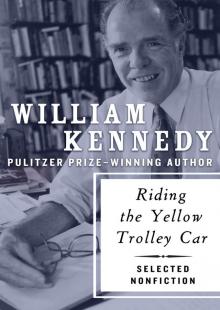 Riding the Yellow Trolley Car: Selected Nonfiction
Riding the Yellow Trolley Car: Selected Nonfiction Changó's Beads and Two-Tone Shoes
Changó's Beads and Two-Tone Shoes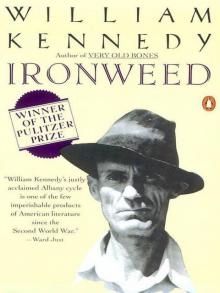 Ironweed
Ironweed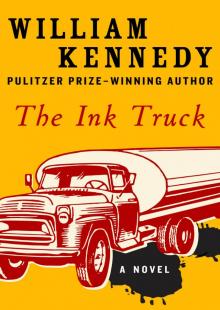 The Ink Truck
The Ink Truck Billy Phelan's Greatest Game
Billy Phelan's Greatest Game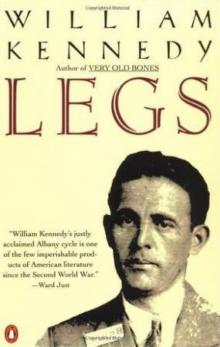 Legs
Legs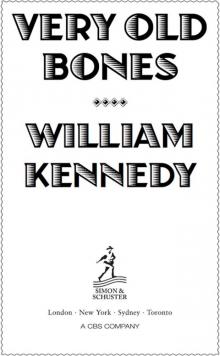 Very Old Bones
Very Old Bones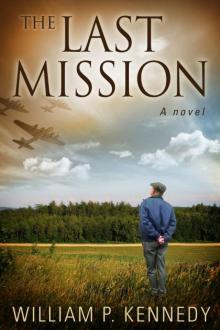 The Last Mission
The Last Mission The Flaming Corsage
The Flaming Corsage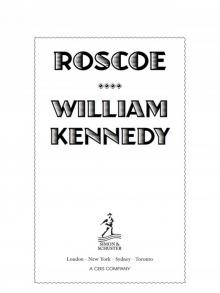 Roscoe
Roscoe Quinn's Book
Quinn's Book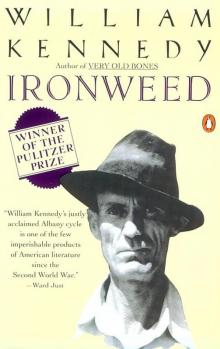 Ironweed (1984 Pulitzer Prize)
Ironweed (1984 Pulitzer Prize) Riding the Yellow Trolley Car
Riding the Yellow Trolley Car Legs - William Kennedy
Legs - William Kennedy